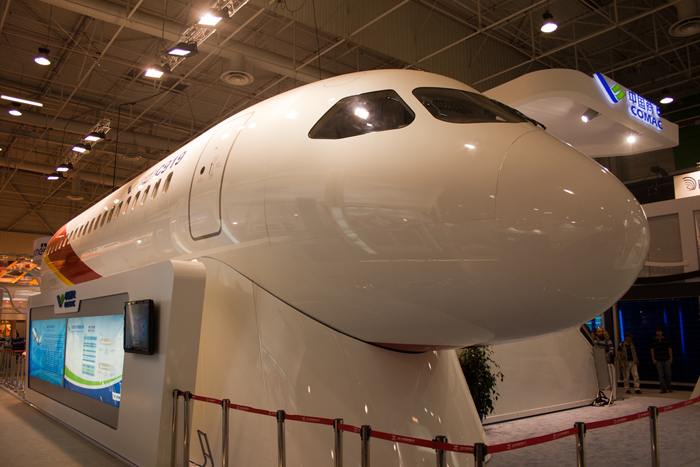For decades, conventional wisdom feared that newly industrialized nations, most notably China, would supplant or “hollow-out” U.S. industry. And, indeed, evidence indicates that by some measurements, China has accumulated the expertise and resources to challenge major pillars of U.S. industrial strength. In textiles, furniture, electronics assembly, metals and basic auto parts, China has slowly driven out American suppliers inside China and around the world. In the last ten years or so, Chinese makers of solar and wind energy equipment, high-speed trains and machine tools have also become dominant — often aided and abetted by concerted industrial strategies on the part of the Chinese government.
The next frontier for China is the aerospace industry, which, of course, carries huge implications for both U.S. national defense and economic strength. Since the early 1980s, when China first induced McDonnell Douglas and later Airbus into assembling jetliners in China and began acquiring advanced technology from the West and the crumbling Soviet Union, China has sunk billions of dollars into the industry. Chinese manufacturers have had some success in military aircraft and space exploration, but China has made little headway in breaking the U.S./European dominance of commercial aviation. More importantly, no breakthroughs are on the horizon, according to a comprehensive new study by the RAND Corporation.[1]
The lessons behind China’s shortfalls in this area — despite aviation being one of the highest-priority industrial policy initiatives in China — are instructive for policymakers both in China and in the West.
After all, Chinese authorities have deployed an impressive array of regulatory, financial and technological resources to foster domestic production. These include: financial subsidies, huge investments in scientific and engineering research, inducements (often bordering on coercion) for external firms to locate in China and transfer technology, deploying students abroad to Western universities and companies to acquire expertise in product and process technology, and procurement requirements favoring indigenous aviation technology. Such a broad assortment of support, especially use of monopsony power and heavy-handed technology-transfer requirements, have had some success in establishing other high technology industries in China, such as high-speed rail and wind power.
Despite all that, it seems that so far, the fears raised by many about the looming dominance of a Chinese high-tech juggernaut are unfounded. Overall, this case study gives some reasons for confidence in the future of U.S. manufacturing.
How has China managed to fall short? Some background helps us understand the relative weakness of China’s commercial aviation sector.[2] China’s ambitions in civil aircraft have been focused on a regional jet labeled the ARJ-21 and a larger, single-aisle aircraft (to compete with the Boeing 737 and Airbus A320) called the C919. Neither plane is yet certified for broad use in civil aviation, even though the C919 alone has received $7 billion to date in development and production subsidies. Even if the C919 is eventually certified, its technology is already at least one generation behind that of the major Western manufacturers like Boeing and Airbus, if not of Embraer and Bombardier as well. Matters aren’t much better for efforts to assemble aircraft designed elsewhere: Chinese factories assembling Airbus and Embraer licensed regional jets domestically haven’t been able to do so at prices competitive with the home production plants in France and Brazil.
About 250,000 workers are employed in the civil aviation sector in China. Industry sales (including parts sold to non-Chinese manufacturers) totaled about $16 billion in 2010. As a proportion of total Chinese industries output, civil aviation is actually shrinking, and represents only 0.17 percent currently, down from 0.22 percent in 2005. This happened against a backdrop of total Chinese industrial production growth of 13 percent annually between 1990 and 2014, catapulting China into the lead in world manufacturing, at least in terms of size. Exports usually account for 13 to 21 percent of Chinese output, but account for only 1 percent of world exports in this sector. Significant parts of regional jets produced in China, including avionics and engine components, are Western in origin. By contrast, in 2010, the United States, with 477,000 workers, generated over $171 billion in output in aviation manufacturing: nearly nine times as productive as the Chinese industry. In 2014, the United States exported around $57 billion in civilian aircraft and nearly as much in aircraft engines and parts, while China struggled to export $3 billion in aircraft and parts.[3] RAND analysts conclude that the Chinese industry “has yet to show that it will be able to produce commercially viable aircraft, much less show that it can become commercially competitive.”[4]
What explains China’s inability to excel in commercial aviation despite successes in other sectors like high speed rail and wind power? Commercial aviation is perhaps an order of magnitude more challenging than even these modern industries. According to RAND, China lags far behind the West in some key aerospace technologies, especially those related to jet engine blades, core engine technology and avionics. Additionally, the next generation of commercial aircraft features new types of basic materials, such as carbon fiber and ceramics, for which the Chinese manufacturers are not competitive. For that matter, Chinese makers of current-generation materials such as aluminum and other light, tensile materials are not advanced enough to compete with leading suppliers to Boeing and Airbus.
What about talent? For over 30 years China has sought to acquire management and production process expertise by requiring foreign manufacturers (now including regional jet leaders Bombardier and Embraer) to assemble planes in China. According to Rand, China successfully used a similar strategy to build up the technology and management expertise needed to displace the Japanese and German technology leaders which supplied China’s earliest high-speed rail segments.
In aerospace, by contrast, Chinese skills at “copying and often improving technology” have proved no match for the rapidly evolving technologies developed by the global aerospace leaders.[5] Equally important, the Chinese have yet to master the exceedingly complex systems-integration skills required for safe, reliable and advanced commercial aviation. These same systems integration challenges are clear from the many problems experienced by Boeing in bringing its 787 Dreamliner to market (and Airbus with its own next-generation aircraft, which is yet to start regular production). Boeing had to integrate new materials that are extremely difficult to produce and assemble in addition to a completely new power system that used electronics rather than hydraulics, all of which required new power systems and more fuel-efficient engines. To make all of these systems work smoothly together in a safe and reliable aircraft requires not only the highest levels of technology sophistication, but also the management flexibility and skills which the Chinese (and even the Japanese) have yet to perfect.
Boeing, according to some reports, has had to rethink its strategy of dispersing component development around the world (partially to satisfy insistent local production-sharing requirements of foreign buyers in Asia and Europe) and separating design from production. Part of Boeing’s competitive advantage is not only technology and management, but knowledge of its production process and workforce. Knowledge of both process and production is vital to new systems integrations. Because China has historically relied on incorporating non-indigenous technology and on joint ventures with foreign firms for learning production techniques, it has never developed the deep underlying understanding of systems integration. For its part, going forward, Boeing is likely to reconsider how much the production process will be separated from design and new technology development.
There are some important lessons to learn from the recent history of global commercial aviation. Perhaps most straightforward is that a targeted industrial policy, even one so well-funded and well-articulated as that of China is this sector, does not always work. New technology does not spring miraculously from basic science and massive capital investments, especially in sectors that require not only technical breakthroughs but also complex system organization to deploy the technologies in the marketplace. Advances more often arise from an integrated system of research and production, building on past technology and process management expertise. Importantly, separating design from production in commercial aviation appears to have impeded competitive advance. Finally, prophets of doom regarding U.S. manufacturing relative to China are underestimating inherent strengths in the structure of U.S. industry and its technology, while also overestimating the power of brute force in China to create industrial champions. Commercial aviation is not the only sector in which China has not displaced Western competitors: other relatively complex industries such as biotechnology, semiconductors, mining and earth-moving equipment, specialty chemicals, and even modern automotive (seen any Chinese cars on U.S. streets lately?) cannot be automatically written off in the United States.
[1] K. Crane, J. Couto, S. Harold, D. Yang, S. Berkowitz, and X. Wang: The Effectiveness of China’s Industrial Policies in Commercial Aviation Manufacturing (Santa Monica, CA: RAND Corporation, 2014), http://www.rand.org/pubs/research_reports/RR245.html.
[2] Unless otherwise noted, all data is taken from the RAND study.
[3] See Bureau of Economic Analysis, U.S. Department of Commerce, “U.S. International Trade in Goods and Services, November 2014,” (Washington: January 7, 2015).
[4] Crane, et al., Effectiveness of China’s Industrial Policies, op. cit., p. xiii.
[5] Ibid, p. 62.


